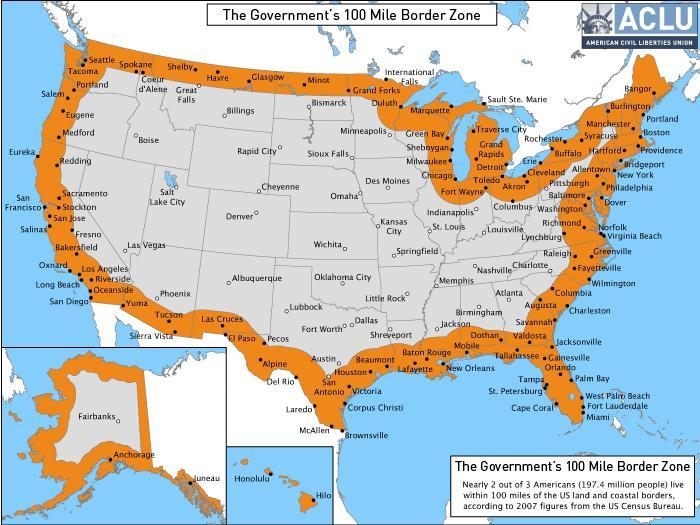The Long History of America’s Constitutionally-Challenged ‘Border Zones’
The extension of Customs and Border Patrol’s mandate to a 100-mile zone has alarmed civil liberties’ groups for years.

The fence between the USA and Mexico along the Pacific Ocean just south of San Diego. (Photo: Tony Webster / CC BY-2.0)
Recently Maria Abi-Habib, a journalist at the Wall Street Journal, had a troubling experience. As she detailed on Facebook (picked up by Motherboard), customs agents at Los Angeles airport tried to take her phones after grilling her for an hour—something she protested as a violation of her rights. But it went further than that. “My rights as a journalist or U.S. citizen do not apply at the border,” she wrote, “since legislation was passed in 2013 giving DHS very broad powers.”
This is true, but the meaning of “border”, a concept that one normally assumes is a hard line, has been shifting for much longer than that. In particular, a technical definition in federal regulations established in 1953 has resulted in 100-mile “border zones,” sometimes encompassing entire states, and some groups becoming increasingly alarmed by the implications of such wide-ranging border areas.

The real U.S. borders? (Photo: ACLU)
In 1952, the government authorized the United States Border Patrol (initially established in 1924) to patrol “all territory within 25 miles of a land border” and board and search vehicles for illegal aliens, according to the website of its successor agency, the U.S. Customs and Border Patrol (CBP). Immigration officers—then and now—receive their authority from Title 8 of the Code of Federal Regulations. Currently, section 287 of Title 8 of the Code of Federal Regulations authorizes immigration officers to search and interrogate, without warrant, any person suspected of being in the United States illegally within a “reasonable distance” of any external boundary of the United States. In 1953, the Department of Justice amended section 287.1 of 8 CFR to define “reasonable distance” as 100 miles, a distance the American Civil Liberties Union insinuates was arbitrarily determined.
“[O]ther than their presence in these publications, there is no public history as to why the Justice Department chose 100 miles as the ‘reasonable distance’ from the border under the INA. It may simply be that 100 miles has a history of being the distance considered to be reasonable regarding the availability of witnesses for examination, responses to subpoenas, and numerous other discovery issues under other federal laws,” the ACLU notes in their fact sheet on the issue.
Given that over two-thirds of the U.S. population lives within 100 miles of an external boundary, the ACLU and others argue that the 100-mile distance—coupled with the expanded mandates afforded to immigration officers as part of the “wars” on drugs and terrorism—creates “border zones” where ordinary American citizens could be caught up in warrantless searches and interrogations with no legal recourse.
Journalist Todd Miller provided a gripping depiction of the alarming scenario in a 2013 article written for the Nation, which he opened with a dramatic recounting of U.S. citizen Shena Gutierrez’s detention by CBP agents in Arizona:
Shena Gutierrez was already cuffed and in an inspection room in Nogales, Arizona, when the Customs and Border Protection (CBP) agent grabbed her purse, opened it, and dumped its contents onto the floor right in front of her. There couldn’t be a sharper image of the Bill of Rights rollback we are experiencing in the US borderlands in the post-9/11 era.
While Gutierrez’s story is a gripping reminder of the protections provided by the Bill of Rights—and the brutality that could be visited upon any citizen if those protections are undermined—it’s reasonable to question whether such a blatant violation of citizens’ rights could occur to any person living in Maine, Vermont, or any of the other states entirely within the 100-mile zone without public outcry.
According to a 2013 blog post from the National Constitution Center, the ACLU and other groups are overstating the threats to constitutional rights within the border zone. Citing two 2009 analysis papers from the Congressional Research Service, the NCC argues that because border agents must have a reasonable suspicion of criminal activity, and because they can only search individuals who have recently crossed the border, most searches should not violate the Fourth Amendment’s protection against unlawful search and seizure; the NCC does, however, note that searches at border stops and airports do not require reasonable suspicion.
The requirement of “reasonableness” has, in fact, been used by federal courts to uphold the legality of warrantless searches in the border zone, as Kate Huddlestone notes in a legal note published in the Yale Law Journal examining the constitutionality of Texas House Bill 2 vis-a-vis the burden it places on undocumented immigrants within border zones. Essentially, because people live and work in border zones, immigration officers must have a reasonable suspicion to conduct a search; if border zones were purely areas of transit (like an airport), officers could (and, as we all know, do) search everyone, no suspicion required.
Of course, illegal searches can and do happen, all the time. But the 100-mile border zones established over 70 years ago may not be the Constitution-free lands of unauthorized search and seizure some fear. Regardless, the border zones serve as a timely reminder that national borders aren’t as cut-and-dry as putting up a wall.








Follow us on Twitter to get the latest on the world's hidden wonders.
Like us on Facebook to get the latest on the world's hidden wonders.
Follow us on Twitter Like us on Facebook